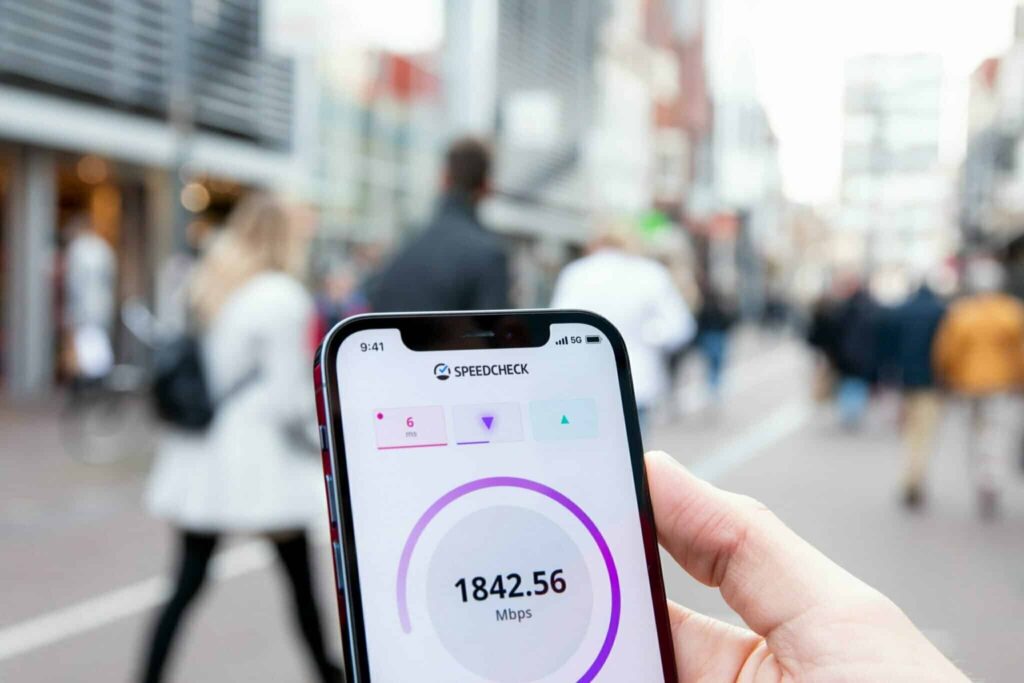Progress and More Progress: How 5G Revolutionizes Various Industries
The four major telecommunications providers in the United Kingdom already operate antennas for the LTE successor in several larger cities, and increasingly in smaller ones, too. 5G is now available in more than 125 U.K. towns and cities.
In March 2021, Ofcom, the British communications regulation authority, issued an auction for the 700 MHz and 3.6 GHz to 3.8 GHz frequency bands, leading to a regional 18% increase in the telecommunications capacity. This capacity will boost 5G deployment and, thus, its speed. EE, owned by the British giant BT Group, was the first operation in the U.K. to launch 5G services in May 2019. O2, Three, and Vodafone jumped into the space shortly afterward. Although Ofcom was able to deploy 5G in numerous cities, it hasn’t met its promises on speed, mainly because of the limited spectrum availability at the time.
The benefit of the 5G investments
A study by Qualcomm and Ericsson performed in November of last year showed tremendous economic promise for the 5G revolution. According to the study, the economic benefit of 5G to the U.K. could be almost EUR 16 billion at a cost of around EUR 2.98 billion — a net benefit in excess of almost EUR 13 billion. This potential economic boom puts the U.K. in one of the top positions compared with the rest of Europe. While the average cost-benefit factor in European countries investigated was 4.5, U.K registered a factor of 7.9.
The study divided the possible areas of 5G use into four clusters:
-
Smart Urban
-
Smart Production and Logistics
-
Smart Rural
-
Smart Public Services.
The main opportunities for the U.K. are in the Smart Urban and Smart Public Services areas. Smart Urban includes the construction sector, local public transportation, and the automotive sector. 5G will lead to decisive CO2 reduction in these sectors, among others. With a cost-benefit factor of 15.9, the U.K. came in second of the European countries investigated — the average value is 7.3. There is also major potential in the area of Smart Public Services, which includes the use of 5G in municipal buildings, hospitals, education, and in tourism. In this area, the U.K. is in ninth place with a factor of 8.3, slightly below the average factor for Europe (8.7).
There could be major changes in the automotive industry as a result of the 5G revolution. According to a survey by the Business Performance Innovation Network (BPI), 70% of IT experts surveyed anticipate serious disruptions in the automotive sector. Foremost in this disruption is connectivity between vehicles, known as car-to-car communication. With the use of 5G, car-to-car communication will be almost free of latency in future, therefore making it possible in near-real time.
There are major developments on the way when it comes to telemedicine too. 5G enables chronically ill people to monitor their own body values and send them to doctors or other care centers. This would also considerably improve the provision of service in rural areas.
5G opportunities and risks
From the consumer’s point of view, the 5G network standard will provide many new opportunities as a result of faster and more reliable mobile internet. For example, both online communication and multimedia apps, like mobile games or streaming high-definition 4K quality, will benefit from higher speeds. The development of the 5G network also means a major step forward for large events, as the network slicing offered by 5G helps avoid overloading and temporary downtime. This divides the network — while part of the 5G network is reserved for the smooth live broadcast of a sporting event, for example, another part can be made available to thousands of stadium visitors.
Smart Home technologies and Smart Metering also present opportunities. Thanks to the new technical possibilities, local energy suppliers can network their gas and water meters together in an intelligent manner. This enables them to read the usage rates for electricity, water, and gas automatically. Smart Home also enables electricity usage and control of electrical equipment in an intelligent manner.
Potential damage to health as a result of mobile radiation is one risk that is frequently mentioned. The use of 5G, however, does not initially change the level of radiation exposure much. Why? Most of the cellular frequencies used for 5G have already been used for 4G, but for other purposes. The strongest radiation, therefore, comes from smartphones that are used close to the body, which makes it irrelevant whether the device is next to users’ ears, in their hands, or in their pockets. The general principle that applies here is that doubling the distance between you and the device decreases the radiation by a quarter.
The next big thing
Nationwide 5G is no longer a distant dream. Telecommunications providers plan to make 5G available across most of the U.K. by the end of 2021. While the four mobile virtual network operators in the U.K. have successfully deployed in more than one hundred cities, their respective speeds may be inconsistent depending on the city. Nonetheless, the British government remains involved to deploy the technology everywhere, especially in rural areas where 5G will improve quality of life.
Meanwhile, research is already underway on the successor to the successor: 6G. An innovation center focused on 6G technology is set to launch at the University of Surrey. Additionally, the British government invested 15 million pounds in related quantum technology. 6G should replace the 5G network on a continuous basis from 2030 and be able to transmit data at 100 times the 5G speed. The future of telecommunications is exciting — and fast.
